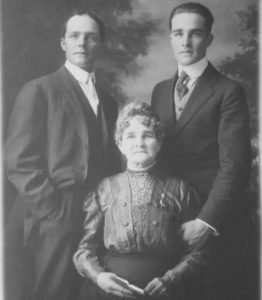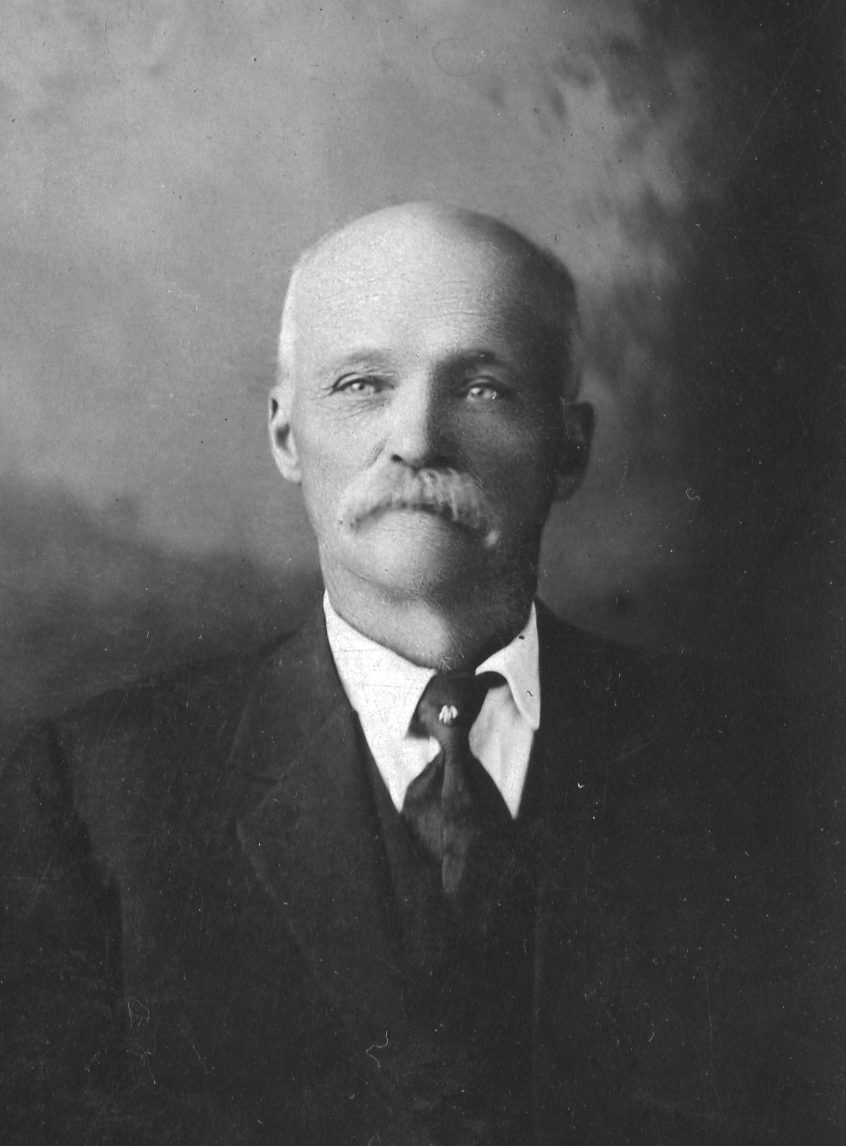TOLMAN, JOSEPH HOLBROOK, was born and raised in Bountiful, Utah. He was born 17 July 1851 and married Emma Adella Wood 27 February, 1870. He also married Mary Ellen Cahoon in the Logan Temple 17 November, 1887.
His earlier life was spent herding sheep for his father. He built a saw mill in Bountiful and it was called a pit mill. He supplied a lot of lumber for the homes in Bountiful. He then sent to Opher and drove the stage for Blyth and Fargo, a biff mining company there. In 1878 he moved to Chesterfield, Bannock Co., Idaho on a homestead where he engaged in farming, carpenter work and blacksmithing. During that period he made all the caskets for that neighborhood. As his family grew he had to move into North Canyon and there he ran a steam saw mill, in which he furnished lumber for Chesterfield, Gentile Valley and Soda Springs. Thru the loss of his saw mill by fire, he moved to Bancroft and bought a saw mill. From that place he furnished the first sidewalk timber that was laid in Pocatello.
From Bancroft he moved the saw mill to Fish Creek. In 1898 he moved to Grace, Idaho, and to there he moved his saw mill and furnished most of the lumber for the last chance Canal Co. From Grace he moved to Inkom with his saw mill. He then moved to Pocatello and went into the dairy business. While in Pocatello he had the contract to build the 6th Ward Church. He also built house for Dell Eldredge in Gentile Valley. He furnished the lumber for the Harkness Grist Mill in McCammon. Also for the Opera House in McCammon. He helped to move the round house and machine shop from Eagle Rock (Idaho Falls) to Pocatello.
In his church activities he was president of the Elders Quorum for about 20 years. Also president of the high priests in the Bannock Stake for some time. He was a Ward teacher all his life. He always had time to have prayer in the family and taught us children to pray. He was also a perfect tithe payer. His son Joseph Hyrum Tolman, worked as chief mechanic at the 0. S. L. repair department, was the church building inspector for the Pocatello Stake, and served for 25 years on the High Council of Pocatello Stake.
Ettie Alinda married Rulon Hofhine, they tried their hand at the hotel business in Salt Lake, at dairying and other things. Nancy’s husband William Banks worked mostly as a railroad grader. Rozella married Wilford Hallam, who was an employee for the Sugar Company at Spanish Fork, also worked at the Tintic Mining Company. Effie married Charles Forkner, farmer and service station and at one time she ran the Meridian hotel at Meridian, Idaho. Nora married John Baker, who was a signal maintenance employee of 0. S. L. for about 40 years, and his son follows the same line of work. Sadie Belle died when her second child was born. Her husband was street supervisor for the city.
EMMA ADELLA WOOD TOLMAN (Pictured with two of her sons, Lamoni Holbrook Tolman and Clarence Henry Tolman)
 TOLMAN, EMMA ADELLA WOOD, was born 31 January, 1852. a daughter of Daniel and Laura Ann Gibbs Wood. I married Joseph Holbrook Tolman 17 February, 1870. My mother came over with the handcart company to the great Salt Lake Valley. As a child I spent many happy hours playing on the foundation of the Salt Lake Temple, and going hand in hand with my mother to meet many other pioneers. I have lived in Idaho about 60 years moving there from Opher, Utah, driving my own team and wagon with my five children, Lamoni being a little over five years old. When we first moved to Idaho we settled in Chesterfield, Idaho. The Bannock Indians were the earliest people there. I never had much trouble with them for I usually gave them what they wanted. Whenever they came to beg for food they would ask where my “Turnip” was, That being what they called my husband.
TOLMAN, EMMA ADELLA WOOD, was born 31 January, 1852. a daughter of Daniel and Laura Ann Gibbs Wood. I married Joseph Holbrook Tolman 17 February, 1870. My mother came over with the handcart company to the great Salt Lake Valley. As a child I spent many happy hours playing on the foundation of the Salt Lake Temple, and going hand in hand with my mother to meet many other pioneers. I have lived in Idaho about 60 years moving there from Opher, Utah, driving my own team and wagon with my five children, Lamoni being a little over five years old. When we first moved to Idaho we settled in Chesterfield, Idaho. The Bannock Indians were the earliest people there. I never had much trouble with them for I usually gave them what they wanted. Whenever they came to beg for food they would ask where my “Turnip” was, That being what they called my husband.
My house and nearly all the houses were made of logs being squared by hand, but later my husband built several saw mills in the hills, then when he built our house he would saw the logs square, also making me a floor out of rough lumber in place of the dirt floor. We had dry good boxes nailed on the walls for clothes closets and cupboards, with ruffled curtains hung up in place of doors. Our furniture was all made by hand. The house had visible rafters, and we stored many things in the attic. Our fruits and vegetables were mostly dried in the attic. When we were in Chesterfield we had to clear our land of sage brush and weeds, we raised some grain, hay and a large vegetable garden, sometimes having to haul water for crops and cattle. We had to melt snow and ice to have water to drink, the winters were so severe. We seldom used money, it being so scarce, so would bargain and trade for almost everything we had or wanted.
We traveled mostly behind a yoke of oxen, and later behind a team of horses in a heavy wagon. The ones who had a buggy were classed as rich. As I remember it was 40 years ago the first buggies were seen in Chesterfield. I used to make lye for soap. I also made our candles as we had no lamps. We used white clay and water with a little blueing to whitewash the inside of our houses. The men folks would buy the bulk lead and make their own bullets, they also made powder horns from the horns of cattle, and their shot gun shells. Being all Mormons and having our own church we used to put on shows and have dances. Some people danced bare-footed and many a sliver I have picked out of my feet. The fiddle and concertina was the music we had. I sometimes played the concertina. Dances started about 8 o’clock and dance till 11 when there would be intermission and refreshments after which we would dance on till morning. Admission was a squash, Chicken, wheat, or anything that amounted to 50 cents. In the winter we had fun sleigh riding. The families were large, one without at least 8 or 10 was not considered a family. The boys usually were raised to become farmers, and the girls were trained in the duties of the home. Children were allowed to run barefooted until 14 or 15 years of age then they would get shoes with copper tips so they would wear longer. Boys married when they became about 18 or 19 and the girl’s 16 or 17. When the wedding was arranged big suppers were given at the home of the bride’s parents. When my babies came we usually hired a lady for a few days and when the baby was a few weeks old we had a celebration or community supper. The women had to do a lot of manual labor in those days.
We had a little school in Chesterfield for the children but most of my children were educated in the home as we generally moved to the mill site where our work was. Thanksgiving, Christmas, and the 4th of July were the only holidays we had, we had picnics, parades, and some of the men would play baseball. I used to card wool and spin it and then send it to ‘he weavers to have it woven into cloth. I made my husband’s suits and they looked very little different than the suits of today. I made my own blankets, as my father raised cotton for the cloth. We moved to Pocatello in 1904. We had a family of 16 children. We have ( ? ) grand children, 75 great-grand children and a number of great great grandchildren.
My father was Daniel C. Wood, my mother Laura Ann Gibbs Wood. She was born 5 March, 1814, in Batavia, Genessee Co., N. Y. Her father and mother were Horace and Blenda Gibbs.
She, Emma, was loved and respected by all. Hers was a merry and jovial nature and many a weary heart has been comforted and cheered by her. She had many heart aches and sorrows but always had a word of cheer for those who were down cast. Her life was given to the service of the needy. She died 10 Aug., 1935, in Pocatello, Idaho, at the general hospital. (This copy submitted by Lamoni Tolman, her son.)
Visit FamilySearch to learn more about Joseph Holbrook Tolman and Emma Adella Wood. Visit the Thomas Tolman Family Organization to find out how you can get more involved in family history.


